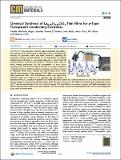Por favor, use este identificador para citar o enlazar a este item:
http://hdl.handle.net/10261/308888COMPARTIR / EXPORTAR:
 SHARE SHARE
 CORE
BASE CORE
BASE
|
|
| Visualizar otros formatos: MARC | Dublin Core | RDF | ORE | MODS | METS | DIDL | DATACITE | |

| Título: | Chemical Synthesis of La0.75Sr0.25CrO3 Thin Films for p-Type Transparent Conducting Electrodes |
Autor: | Machado, Pamela; Guzmán, Roger CSIC ORCID; Morera, Ramon J.; Alcalà, Jordi; Palau, Anna CSIC ORCID; Zhou, Wu; Coll, Mariona CSIC ORCID | Fecha de publicación: | 13-abr-2023 | Editor: | American Chemical Society | Citación: | Chemistry of Materials 35(9): 3513–3521 (2023) | Resumen: | The imperative need for highly performant and stable p-type transparent electrodes based on abundant metals is stimulating the research on perovskite oxide thin films. Moreover, exploring the preparation of these materials with the use of cost-efficient and scalable solution-based techniques is a promising approach to extract their full potential. Herein, we present the design of a chemical route, based on metal nitrate precursors, for the preparation of pure phase La0.75Sr0.25CrO3 (LSCO) thin films to be used as a p-type transparent conductive electrode. Different solution chemistries have been evaluated to ultimately obtain dense, epitaxial, and almost relaxed LSCO films. Optical characterization of the optimized LSCO films reveals promising high transparency with ∼67% transmittance while room temperature resistivity values are 1.4 Ω·cm. It is suggested that the presence of structural defects, i.e., antiphase boundaries and misfit dislocations, affects the electrical behavior of LSCO films. Monochromated electron energy loss spectroscopy allowed changes in the electronic structure in LSCO films to be determined, revealing the creation of Cr4+ and unoccupied states at the O 2p upon Sr-doping. This work offers a new venue to prepare and further investigate cost-effective functional perovskite oxides with potential to be used as p-type transparent conducting electrodes and be easily integrated in many oxide heterostructures. | Versión del editor: | http://doi.org/10.1021/acs.chemmater.2c03831 | URI: | http://hdl.handle.net/10261/308888 | DOI: | 10.1021/acs.chemmater.2c03831 | ISSN: | 0897-4756 |
| Aparece en las colecciones: | (ICMAB) Artículos |
Ficheros en este ítem:
| Fichero | Descripción | Tamaño | Formato | |
|---|---|---|---|---|
| Machado_ChemMater_2023_editorial.pdf | Artículo principal | 11,21 MB | Adobe PDF |  Visualizar/Abrir |
| Machado_ChemMater_2023_suppl_editorial.pdf | Información complementaria | 2,54 MB | Adobe PDF |  Visualizar/Abrir |
CORE Recommender
SCOPUSTM
Citations
3
checked on 22-may-2024
WEB OF SCIENCETM
Citations
2
checked on 26-feb-2024
Page view(s)
47
checked on 23-may-2024
Download(s)
54
checked on 23-may-2024
Google ScholarTM
Check
Altmetric
Altmetric
Este item está licenciado bajo una Licencia Creative Commons

